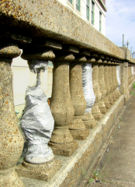22nd Street viaduct: Difference between revisions
Jump to navigation
Jump to search
No edit summary |
(dammit) |
||
| Line 1: | Line 1: | ||
[[Image:Wrapped baluster.jpg|right|thumb|135px|Detail of the balustrade in June 2002]] | [[Image:Wrapped baluster.jpg|right|thumb|135px|Detail of the balustrade in June 2002]] | ||
The '''22nd Street viaduct''' | The '''22nd Street viaduct''' is a road bridge constructed in [[1915]] connecting [[22nd Street South]] to [[22nd Street North]] over the [[Railroad Reservation]], [[Morris Avenue]] to the north and [[Powell Avenue]] to the south. | ||
The east edge of the viaduct is built directly adjacent to a building on the south side of Morris Avenue. The portion of the building's wall projecting above the span was used as the site for "[[Geo-Chromatic Progress]]", one of [[Michael Mojher]]'s paintings completed under the auspices of the [[Birmingham Mural Project|Birmingham Urban Mural Project]] in [[1978]]. | The east edge of the viaduct is built directly adjacent to a building on the south side of Morris Avenue. The portion of the building's wall projecting above the span was used as the site for "[[Geo-Chromatic Progress]]", one of [[Michael Mojher]]'s paintings completed under the auspices of the [[Birmingham Mural Project|Birmingham Urban Mural Project]] in [[1978]]. | ||
Revision as of 11:45, 12 January 2011
The 22nd Street viaduct is a road bridge constructed in 1915 connecting 22nd Street South to 22nd Street North over the Railroad Reservation, Morris Avenue to the north and Powell Avenue to the south.
The east edge of the viaduct is built directly adjacent to a building on the south side of Morris Avenue. The portion of the building's wall projecting above the span was used as the site for "Geo-Chromatic Progress", one of Michael Mojher's paintings completed under the auspices of the Birmingham Urban Mural Project in 1978.
The span gained a degree of local press in the summer of 2000 when the city used duct tape to temporarily fix crumbling balusters while waiting for appropriations from ALDOT for more permanent repairs.
References
- "Facts About Birmingham's New Viaduct" (October 1915) The Birmingham Magazine - via Birmingham Public Library Digital Collections
- MacDonald, Ginny (July 7, 2000) "Duct tape bridges the gap." Birmingham News.
